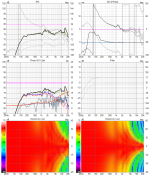So using the 5x derivative as it’s the only one Keele thinks has a practical purpose……the two outermost drivers are the main energy drivers of the system with each unit representing one 1/4 wave spacing…….would that suggest that the overall dispersion pattern would be equal to that of the diameter of the same size cone?……let’s say the 5 combined distance is 8”…….are we now talking about the same dispersion characteristics of an 8” cone or point source?………
If you have enough dispersion info on the smaller driver you plan to use, it's easy to check what happens within Vituixcad.
You can even generate a raw version of that dispersion based on driver size information with Vituixcad if you don't have it available.
Here's a 5 driver Bessel using the TC9 driver (vertical array, at 5m distance):


You can even generate a raw version of that dispersion based on driver size information with Vituixcad if you don't have it available.
Here's a 5 driver Bessel using the TC9 driver (vertical array, at 5m distance):
Attachments
Thank you! I’ll have to download Vituixcad and get familiar with it. I ordered 5 of the 16ohm Faital 3FE drivers last night for the horizontal center channel speaker design. Your polars of the Bessel confirmed my suspicions that this will produce excellent intelligibility out past 30 degrees of center and should lock the sound to the screen as well. I don’t think there’s any other way to accomplish the design tasks with such a limited footprint and placement than this.
I ‘could’ use smaller drivers with even better off axis response, but all of those flounder in the 80db efficiency range so not really a mission for a typical AVR where the amp would be choking and power compression of the drivers would make for a mess. If the proof of concept is supported, I’ll build another with the Tectonic 3” BMR for comparison. I chose the Faital for the initial attempt for the impedance load……the Tecton driver is 4ohm only so I’d be giving up efficiency again when forced to use the series wiring implementation.
I ‘could’ use smaller drivers with even better off axis response, but all of those flounder in the 80db efficiency range so not really a mission for a typical AVR where the amp would be choking and power compression of the drivers would make for a mess. If the proof of concept is supported, I’ll build another with the Tectonic 3” BMR for comparison. I chose the Faital for the initial attempt for the impedance load……the Tecton driver is 4ohm only so I’d be giving up efficiency again when forced to use the series wiring implementation.
This thread: https://www.diyaudio.com/community/...heir-behavior-through-simple-modeling.388279/
might be of some use to you 🙂.
might be of some use to you 🙂.
Got the parts in the door just now, the simulations are very exciting!

If that is correct and I can get such a response using a relaxed sloping function + a -2.5dB dip and a +2.5dB peak, and some taming of a peak at 12kHz, with an 8 driver array, this will get really exciting.
This is not a Bessel array like in the patent, not the same circuit, I would call it something like a "Pure" Bessel Array or something, or perhaps "Idealistic".
If that is correct and I can get such a response using a relaxed sloping function + a -2.5dB dip and a +2.5dB peak, and some taming of a peak at 12kHz, with an 8 driver array, this will get really exciting.
This is not a Bessel array like in the patent, not the same circuit, I would call it something like a "Pure" Bessel Array or something, or perhaps "Idealistic".
Last edited:
Considering sacrificing a bit of off axis response for a tiny bit more SPL. Think it is still looking pretty good at -4dB/10kHz 70 degrees off axis.
This is with some very gentle nudging here and there, only 5 EQ bands per channel (Array tops + Bass) and relatively simple 12dB/oct Bessel filters.
Phase sums super smooth.
Will be exciting to see if this is compareable to real life, all the drivers are in house, hoping for a bit of time to make sawdust soon.

This is with some very gentle nudging here and there, only 5 EQ bands per channel (Array tops + Bass) and relatively simple 12dB/oct Bessel filters.
Phase sums super smooth.
Will be exciting to see if this is compareable to real life, all the drivers are in house, hoping for a bit of time to make sawdust soon.
- Home
- Loudspeakers
- Multi-Way
- Understanding Bessel array radiation patterns?
